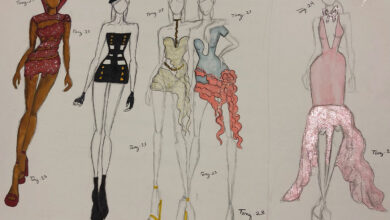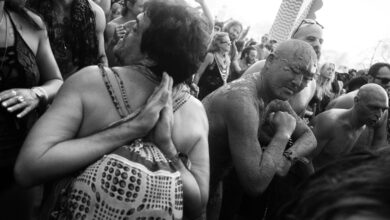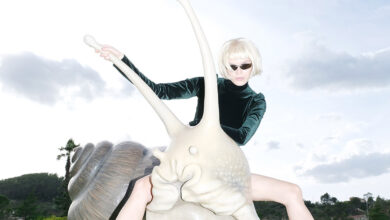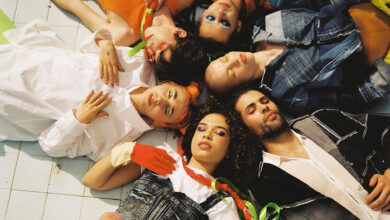“Portuguese fashion has the brightness of the catwalk but it lacks the brightness of the city”
 Luís Buchinho is 41 years of age and has been designing fashion for the last 20. He started working as Portuguese fashion took its first steps and he is now one of the most respected names in the industry. His creations are “urban, casual, practical and realistic”, a female version of what he himself likes to wear. He was born in Setúbal, studied in Porto and is living in the latter. He hopes to open a shop in Lisbon and despite the global economic crisis he has no complaints about business.
Luís Buchinho is 41 years of age and has been designing fashion for the last 20. He started working as Portuguese fashion took its first steps and he is now one of the most respected names in the industry. His creations are “urban, casual, practical and realistic”, a female version of what he himself likes to wear. He was born in Setúbal, studied in Porto and is living in the latter. He hopes to open a shop in Lisbon and despite the global economic crisis he has no complaints about business.
Text by Bruno Horta
Photos by Thomas Probosch
Zoot Magazine: Why do you have such a low profile attitude?
Luis Buchinho: My collections speak for me, that’s my principle. I don’t dislike appearing in the press but I like to focus on my work. In Portugal things don’t always work that way. In many cases, the work is just an excuse for the promotion of some egos. Portuguese fashion has always had more media and social phenomena than people with good working capacity.
Zoot Magazine: Has that discretion ever harmed you?
Luis Buchinho: I am one of the most important people within national fashion, I don’t feel my position is wrong. People don’t see me as an ephemeral phenomenon, they learned to respect me.
Zoot Magazine: You began working in fashion in 1990. How did it happen?
Luis Buchinho: I finished a fashion design degree in 1989 and in 1990 I presented my first collection at a young designer’s fair that existed in Porto, the Portex. I won the first prize. Then I went right to ModaLisboa and presented an individual collection and I haven’t stopped since then.
Zoot Magazine: Your entry into ModaLisboa was by invitation as usual?
Luis Buchinho: It was by invitation of Eduarda [Abbondanza] and Mario [Matos Ribeiro]. At that time they were creating the “zero edition” of ModaLisboa and they wanted new talent. In 1990, I took part in a collective fashion show but from April 1991 onwards we all started doing the current format of individual shows.
Zoot Magazine: Today everyone likes to go to ModaLisboa and all the Portuguese press want to be there. How was it different at that time?
Luis Buchinho: Very different. We didn’t have the amount of press that we have today. 20 years ago there were only two television channels in Portugal and two or three important magazines. There was no Internet. We didn’t have access to what was happening outside the country in terms of fashion. This situation didn’t allow the collections to be spoken about by people as they are now but to be fair I have to say, we would still reach a certain impact.
Zoot Magazine: Fashion is always fascinating…
Luis Buchinho: It’s a magnet of public interest. It”s not like football, but it seems that way sometimes.
Zoot Magazine: Was it that fascination that made you want to be a designer?
Luis Buchinho: No. I was one of those kids that would spend all their time drawing. I knew I wanted to do something related to art, and I would probably study Fine Art, but at 15 or 16 years old that interest turned to fashion, much under the influence of some foreign magazines that I read, like Smash It or Bravo. Pop culture has always fascinated me. And pop culture has a lot of style.
Zoot Magazine: What kind of drawings did you do?
Luis Buchinho: Comics and cartoons, then singers and album covers. And then I started doing fashion illustration on my own.
Zoot Magazine: Where you a shy boy?
Luis Buchinho: More or less. I always had a core of small but good friends.
Zoot Magazine: Your look is very simple. Did you always dress like that?
Luis Buchinho: Yes but with the normal adjustments to trends over the years. The relationship I have with my clothes is a kind of friendship; I have some very comfortable and practical pieces that I like very much.
Zoot Magazine: That seems surprising coming from a fashion designer.
Luis Buchinho: It’s just the way I am. You can see that my female imagery is not far from simplicity, even the women”s evening-wear and cocktail dresses portray that simplicity. I would say 80% of my collections are a female version of what I wear.
Zoot Magazine: What are the characteristics of your creations today?
Luis Buchinho: They are casual, practical and comfortable with some urban sophistication. They are made for a very secure and positive woman of 20 or 60 years old. I really appreciate working the silhouette and creating pieces that conceal imperfections of the figure. My clothes are very dynamic.
Zoot Magazine: How would you describe your early work?
Luis Buchinho: It was more naive, sweet and romantic. Today I have a more aggressive style but 20 years ago I still had a lyrical universe. I matured and ‘my wife’ also did. I became selective in terms of colours and shapes, a bit more austere. I was known for working with pastel colours: yellow, pink and green. Colours that I almost never use today.
Zoot Magazine: You studied fashion design in Porto…
Luis Buchinho: It was the idea of a teacher. She showed me an advert of a school in Porto, CITEX [Centro de Formação Profissional da Indústria Têxtil], and told me it was the right place for me. I went without high expectations. I was only 16. Within three months I was living in Porto.
Zoot Magazine: You said in interviews that that phase was very difficult.
Luis Buchinho: I was very young and I was very attached to family and friends. It was a shock. At that time, in 1986, a degree in Fashion Design in Portugal was an enigma, no one knew what it meant in terms of job security. Adapting to Porto was not easy either, I was used to a smaller town with beach and sun.
Zoot Magazine: Was that degree useful?
Luis Buchinho: It was excellent. It gave me a lot of expertise. It was a very demanding degree with firm schedules. We worked as if we were in a factory, almost like a military regime. The teachers were from the area of Fine Art. Not like today when teachers know fashion and come from the fashion area. We were at the dawn of fashion in Portugal. There was Ana Salazar [designer] and little more.
Soon after the degree you were working for a knitting company, Jotex.
Zoot Magazine: When did you realize that you also wanted to have your own brand.
Luis Buchinho: I was involved in both areas. I finished the degree in December 1989 and was soon contacted by Jotex. At the same time I began to prepare a fashion show for the Portex contest – the one I already mentioned – and I started as a designer on my own.
Zoot Magazine: Not only in your case but in general women”s clothes are much more common that menswear. Why?
Luis Buchinho: I recognize that men are nowadays much more concerned with what they wear. Men”s clothing has changed significantly in recent years in terms of colours and shapes and there are now collections with very good quality and great quantity but it is still a universe that doesn’t interest me. I enjoy working with colours and shapes, with silhouettes that change season after season. The universe of men, at least that I would produce, is much more limited. True fashion is feminine clothes.
Zoot Magazine: Do you think Portuguese fashion is already speaking a global language or is there a proper Portuguese way of making fashion?
Luis Buchinho: In some cases it speaks a universal language. Today with rapid and global information there is no reason for Portuguese clothes to be less interesting than the ones made worldwide. I don’t think we can say there is a Portuguese fashion design common language. Each designer is a unique case.
Zoot Magazine: You’re saying it makes no sense to have a national language but an individual language.
Luis Buchinho: Exactly.
Zoot Magazine: We frequently hear complaints about something that is missing in Portuguese fashion. What is it?
Luis Buchinho: It’s the commercial side beyond the catwalks. Portuguese fashion doesn’t reach people because it’s hardly sold on stores. It has the lights of the catwalk but it lacks the lights of the city. That’s a real obstacle to fashion designers, because it prevents them from growing as professionals. When you create to be produced you become mature, but when you create just to show it on the catwalk…
Zoot Magazine: Social networks and blogs on the Internet may help Portuguese fashion to reach the city light?
Luis Buchinho: The Internet doesn’t create distribution networks. Designers have to work as a brand because what people buy are brands. That aspect is not really perceived by Portuguese designers. There are many people who lean upon the fact that they are supported [State grants].
Zoot Magazine: What is your strategy?
Luis Buchinho: I do the possible and the impossible to sell my collections. Right now, I work with 35 multi-brand outlets in Portugal. I consider it a respectable number. It was not easy to achieve.
Zoot Magazine: It is often said that the Portuguese textile industry is not prepared to produce designer’s ideas. Do you agree?
Luis Buchinho: This is an effort that many designers don’t want to make. There are small factories in Portugal very well adapted to middle-quantity production. It’s not easy to reach these factories and sometimes people tend to quit. Designers are more akin to a playful and artistic way of thinking. We don’t like to deal with these issues. I don’t know anyone who is a fashion designer that also knows how to make money but it is something which has to be done. In Portugal a fashion designer has to be both a creator and a manager at the same time.
Zoot Magazine: You have only one store of your own, in Porto. Are you thinking of opening one in Lisbon?
Luis Buchinho: It’s a medium-term goal.
Zoot Magazine: Is Luís Buchinho a strong brand despite the economic and financial crisis?
Luis Buchinho: Given the situation it’s a strong brand. It has been growing for the past year and a half. That’s good news.
Luis Buchinho has just presented his first Menswear collection at Portugal Fashion. Please also check out ZOOT”S backstage reports about Luis Buchinho”s and collection at ModaLisboa.
Production Assistants Catia Nobrega and Isabel Maia Aguiar















